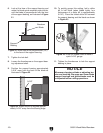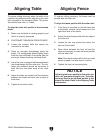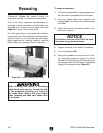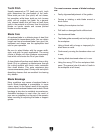
-28-
G0621 Wood/Metal Bandsaw
"Resawing" (Figure 34) means cutting the
workpiece into two or more thinner workpieces.
One of the most important considerations for
resawing is blade selection—a wide blade cuts
straighter and is less prone to blade lead (see
Page 41 for more info on blade lead).
For most applications, use a blade with a hook or
a skip tooth style. Choose blades with fewer teeth-
per-inch (from 3 to 6), because they offer larger
gullet capacities for clearing sawdust, reducing
heat buildup and reducing strain on the motor.
Figure 34. Typical resawing operation.
When resawing thin pieces, a wandering
blade (blade lead) can tear through the side
of the workpiece, exposing your hands to
the blade teeth. Always use push blocks
when resawing and keep your hands clear
of the blade.
To resaw a workpiece:
1. Verify that the bandsaw is setup properly and
that the table is perpendicular to the blade.
2. Use the widest blade your bandsaw will
accept. Note: The blade must also be sharp
and clean.
3. Adjust the fence to the desired width of cut,
and lock it in place.
4. Support the ends of the board if necessary.
5. Turn the bandsaw ON.
6. Using push paddles and a push stick, main-
tain workpiece pressure against the fence
and table, and slowly feed the workpiece into
the moving blade until the blade is completely
through the workpiece (see
Figure 34).
NOTICE
The scale on the front rail will NOT be accu-
rate when using the resaw fence.
Resawing


















